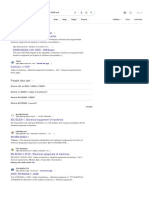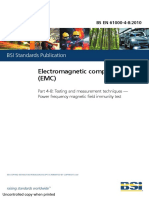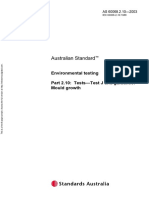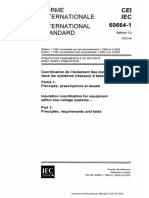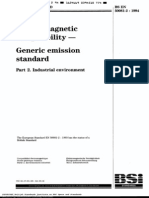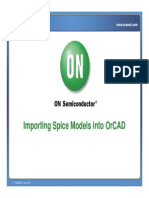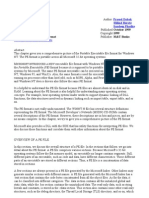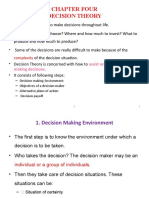En 61000-6-3 - 2007 PDF
En 61000-6-3 - 2007 PDF
Uploaded by
madslayersCopyright:
Available Formats
En 61000-6-3 - 2007 PDF
En 61000-6-3 - 2007 PDF
Uploaded by
madslayersOriginal Title
Copyright
Available Formats
Share this document
Did you find this document useful?
Is this content inappropriate?
Copyright:
Available Formats
En 61000-6-3 - 2007 PDF
En 61000-6-3 - 2007 PDF
Uploaded by
madslayersCopyright:
Available Formats
BRITISH STANDARD
BS EN
61000-6-3:2007
Electromagnetic
compatibility (EMC)
Part 6-3: Generic standards Emission
standard for residential, commercial
and light-industrial environments
The European Standard EN 61000-6-3:2007 has the status of a
British Standard
ICS 33.100.10
12 &23<,1* :,7+287 %6, 3(50,66,21 (;&(37 $6 3(50,77(' %< &23<5,*+7 /$:
BS EN 61000-6-3:2007
This British Standard was
published under the authority
of the Standards Policy and
Strategy Committee
on 28 February 2007
BSI 2007
ISBN 978 0 580 50239 2
National foreword
This British Standard was published by BSI. It is the UK implementation of
EN 61000-6-3:2007. It is identical with IEC 61000-6-3:2006. It supersedes
BS EN 61000-6-3:2001, which will be withdrawn on 1 December 2009.
The UK participation in its preparation was entrusted by Technical Committee
GEL/210, EMC Policy committee, to Subcommittee GEL/210/12,
EMC Basic and generic standards.
A list of organizations represented on GEL/210/12 can be obtained on request
to its secretary.
This publication does not purport to include all the necessary provisions of a
contract. Users are responsible for its correct application.
Compliance with a British Standard cannot confer immunity from
legal obligations.
Amendments issued since publication
Amd. No. Date Comments
EUROPEAN STANDARD
EN 61000-6-3
NORME EUROPENNE
EUROPISCHE NORM
January 2007
CENELEC
European Committee for Electrotechnical Standardization
Comit Europen de Normalisation Electrotechnique
Europisches Komitee fr Elektrotechnische Normung
Central Secretariat: rue de Stassart 35, B - 1050 Brussels
2007 CENELEC - All rights of exploitation in any form and by any means reserved worldwide for CENELEC members.
Ref. No. EN 61000-6-3:2007 E
ICS 33.100.10 Supersedes EN 61000-6-3:2001 + A11:2004
English version
Electromagnetic compatibility (EMC) -
Part 6-3: Generic standards -
Emission standard for residential, commercial
and light-industrial environments
(IEC 61000-6-3:2006)
Compatibilit lectromagntique (CEM) -
Partie 6-3: Normes gnriques -
Norme sur l'mission
pour les environnements rsidentiels,
commerciaux et de l'industrie lgre
(CEI 61000-6-3:2006)
Elektromagnetische Vertrglichkeit
(EMV) -
Teil 6-3: Fachgrundnormen -
Straussendung fr Wohnbereich,
Geschfts- und Gewerbebereiche
sowie Kleinbetriebe
(IEC 61000-6-3:2006)
This European Standard was approved by CENELEC on 2006-12-01. CENELEC members are bound to comply
with the CEN/CENELEC Internal Regulations which stipulate the conditions for giving this European Standard
the status of a national standard without any alteration.
Up-to-date lists and bibliographical references concerning such national standards may be obtained on
application to the Central Secretariat or to any CENELEC member.
This European Standard exists in three official versions (English, French, German). A version in any other
language made by translation under the responsibility of a CENELEC member into its own language and notified
to the Central Secretariat has the same status as the official versions.
CENELEC members are the national electrotechnical committees of Austria, Belgium, Bulgaria, Cyprus, the
Czech Republic, Denmark, Estonia, Finland, France, Germany, Greece, Hungary, Iceland, Ireland, Italy, Latvia,
Lithuania, Luxembourg, Malta, the Netherlands, Norway, Poland, Portugal, Romania, Slovakia, Slovenia, Spain,
Sweden, Switzerland and the United Kingdom.
Foreword
The text of document CISPR/H/121/FDIS, future edition 2 of IEC 61000-6-3, prepared by CISPR SC H,
Limits for the protection of radio services, was submitted to the IEC-CENELEC parallel vote and was
approved by CENELEC as EN 61000-6-3 on 2006-12-01.
This European Standard supersedes EN 61000-6-3:2001 + A11:2004.
The major changes in EN 61000-6-3:2007 are the inclusion of a clause on tests for equipment in series
production, a new clause on measurement uncertainty and the inclusion of requirements on dc power
ports and telecommunications ports. The informative annex has been deleted.
The following dates were fixed:
latest date by which the EN has to be implemented
at national level by publication of an identical
national standard or by endorsement
(dop)
2007-09-01
latest date by which the national standards conflicting
with the EN have to be withdrawn
(dow)
2009-12-01
This European Standard has been prepared under a mandate given to CENELEC by the European
Commission and the European Free Trade Association and covers essential requirements of
EC Directives EMC (89/336/EEC), EMC (2004/108/EC) and RTTED (1999/5/EC). See Annex ZZ.
Annexes ZA and ZZ have been added by CENELEC.
__________
Endorsement not i ce
The text of the International Standard IEC 61000-6-3:2006 was approved by CENELEC as a European
Standard without any modification.
__________
EN 61000-6-3:2007 2
3 EN 61000-6-3:2007
CONTENTS
INTRODUCTION...................................................................................................................4
1 Scope and object ............................................................................................................5
2 Normative references .....................................................................................................6
3 Terms and definitions .....................................................................................................7
4 Conditions during testing ................................................................................................8
5 Product documentation ...................................................................................................8
6 Applicability....................................................................................................................9
7 Emission requirements ...................................................................................................9
8 Application of limits in tests for conformity of equipment in series production ...................9
9 Measurement uncertainty..............................................................................................10
Annex ZA (normative) Normative references to international publications with their
corresponding European publications............................................................................14
Annex ZZ (informative) Coverage of Essential Requirements of EC Directives ....................16
Bibliography .......................................................................................................................13
Figure 1 Examples of ports ................................................................................................7
Table 1 Emission .............................................................................................................11
EN 61000-6-3:2007 4
4
INTRODUCTION
IEC 61000 is published in separate parts according to the following structure:
Part 1: General
General considerations (introduction, fundamental principles)
Definitions, terminology
Part 2: Environment
Description of the environment
Classification of the environment
Compatibility levels
Part 3: Limits
Emission limits
Immunity limits (insofar as they do not fall under the responsibility of the product
committees)
Part 4: Testing and measurement techniques
Measurement techniques
Testing techniques
Part 5: Installation and mitigation guidelines
Installation guidelines
Mitigation methods and devices
Part 6: Generic standards
Part 9: Miscellaneous
Each part is further subdivided into several parts published either as International Standards
or technical reports/specifications, some of which have already been published as sections.
Others will be published with the part number followed by a dash and a second number
identifying the subdivision (example: 61000-6-1).
5 EN 61000-6-3:2007
ELECTROMAGNETIC COMPATIBILITY (EMC)
Part 6-3: Generic standards
Emission standard for residential,
commercial and light-industrial environments
1 Scope and object
This part of IEC 61000 for EMC emission requirements applies to electrical and electronic
apparatus intended for use in residential, commercial and light-industrial environments.
Emission requirements in the frequency range 0 Hz to 400 GHz are covered. No
measurement needs to be performed at frequencies where no requirement is specified.
This generic EMC emission standard is applicable if no relevant dedicated product or product-
family EMC emission standard exists.
This standard applies to apparatus intended to be directly connected to a low-voltage public
mains network or connected to a dedicated DC source, which is intended to interface between
the apparatus and the low-voltage public mains network. This standard applies also to
apparatus which is battery operated or is powered by a non-public, but non-industrial, low-
voltage power distribution system if this apparatus is intended to be used in the locations
described below.
The environments encompassed by this standard are residential, commercial and light-
industrial locations, both indoor and outdoor. The following list, although not comprehensive,
gives an indication of locations that are included:
residential properties, for example houses, apartments;
retail outlets, for example shops, supermarkets;
business premises, for example offices, banks;
areas of public entertainment, for example cinemas, public bars, dance halls;
outdoor locations, for example petrol stations, car parks, amusement and sports centres;
light-industrial locations, for example workshops, laboratories, service centres.
Locations that are characterised by being supplied directly at low voltage from the public
mains network are considered to be residential, commercial or light-industrial.
The object of this standard is to define the emission test requirements for apparatus defined
in the scope in relation to continuous and transient, conducted and radiated disturbances.
The emission requirements have been selected so as to ensure that disturbances generated
by apparatus operating normally in residential, commercial and light-industrial locations do
not exceed a level which could prevent other apparatus from operating as intended. Fault
conditions of apparatus are not taken into account. Not all disturbance phenomena have been
included for testing purposes in this standard but only those considered as relevant for the
equipment covered by this standard. These requirements represent essential electromagnetic
compatibility emission requirements.
EN 61000-6-3:2007 6
6
Requirements are specified for each port considered.
NOTE 1 Safety considerations are not covered by this standard.
NOTE 2 In special cases, situations will arise where the levels specified in this standard will not offer adequate
protection; for example where a sensitive receiver is used in close proximity to an apparatus. In these instances,
special mitigation measures may have to be employed.
NOTE 3 As the requirements in this standard are more stringent than the requirements in IEC 61000-6-4,
equipment fulfilling the requirements of this standard will also comply with the requirements of IEC 61000-6-4.
2 Normative references
The following referenced documents are indispensable for the application of this document.
For dated references, only the edition cited applies. For undated references, the latest edition
of the referenced document (including any amendments) applies.
IEC 61000-3-2, Electromagnetic compatibility (EMC) Part 3-2: Limits Limits for harmonic
current emissions (equipment input current 16 A per phase)
IEC 61000-3-3, Electromagnetic compatibility (EMC) Part 3-3: Limits Limitation of voltage
fluctuations and flicker in low-voltage supply systems for equipment with rated current 16 A
IEC 61000-3-11, Electromagnetic compatibility (EMC) Part 3-11: Limits Limitation of
voltage changes, voltage fluctuations and flicker in public low-voltage supply systems
Equipment with rated current 75 A and subject to conditional connection
IEC 61000-3-12, Electromagnetic compatibility (EMC) Part 3-12: Limits Limits for
harmonic currents produced by equipment connected to public low-voltage systems with input
current >16 A and 75 A per phase
CISPR 14-1: Electromagnetic compatibility Requirements for household appliances, electric
tools and similar apparatus Part 1: Emission
CISPR 16-1-2:2003, Specification for radio disturbance and immunity measuring apparatus
and methods Part 1-2: Radio disturbance and immunity measuring apparatus Ancillary
equipment Conducted disturbances
CISPR 16-2-1:2003, Specification for radio disturbance and immunity measuring apparatus
and methods Part 2-1: Methods of measurement of disturbances and immunity Conducted
disturbance measurements
CISPR 16-2-3, Specification for radio disturbance and immunity measuring apparatus and
methods Part 2-3: Methods of measurement of disturbances and immunity Radiated
disturbance measurements
CISPR 16-4-2, Specification for radio disturbance and immunity measuring apparatus and
methods Part 4-2: Uncertainties, statistics and limit modelling Uncertainty in EMC
measurements
CISPR 22, Information technology equipment Radio disturbance characteristics Limits and
methods of measurement
7 EN 61000-6-3:2007
3 Terms and definitions
For the purposes of this document, the following terms and definitions apply.
NOTE Definitions related to EMC and to relevant phenomena are given in IEC 60050-161 and in other IEC and
CISPR publications.
3.1
port
particular interface of the specified apparatus with the external electromagnetic environment
(see Figure 1)
Enclosure port
Low voltage
a.c. mains port
Apparatus
Telecommunications/
network port
DC power port
Figure 1 Examples of ports
3.2
enclosure port
physical boundary of the apparatus which electromagnetic fields may radiate through or
impinge on
3.3
cable port
port at which a conductor or a cable is connected to the apparatus
NOTE Examples are signal, control and power ports.
3.4
telecommunications/network port
point of connection for voice, data and signalling transfers intended to interconnect widely
dispersed systems via such means as direct connection to multi-user telecommunications
networks (e.g. public switched telecommunications networks (PSTN) integrated services
digital networks (ISDN), x-type digital subscriber lines (xDSL), etc.), local area networks (e.g.
Ethernet, Token Ring, etc.) and similar networks)
NOTE A port generally intended for interconnection of components of an ITE system under test (e.g. RS-232,RS-
485, field buses in the scope of IEC 61158, IEEE Standard 1284 (parallel printer), Universal Serial Bus (USB),
IEEE Standard 1394 (Fire Wire), etc.) and used in accordance with its functional specifications (e.g. for the
maximum length of cable connected to it), is not considered to be a telecommunications port.
3.5
power port
port at which a conductor or cable carrying the primary electrical power needed for the
operation (functioning) of an apparatus or associated apparatus is connected to the apparatus
IEC 1091/06
EN 61000-6-3:2007 8
8
3.6
public mains network
electricity lines to which all categories of consumers have access and which are operated by
a supply or distribution undertaking for the purpose of supplying electrical energy
3.7
low voltage
LV
low tension
voltage having a value below a conventionally adopted limit
[IEV 601-01-26, modified]
NOTE For the distribution of AC electric power, the upper limit is generally accepted to be 1 000 V.
3.8
d.c. power network
local electricity supply network in the infrastructure of a certain site or building intended for
flexible use by one ore more different types of equipment and guaranteeing continuous power
supply independently from the conditions of the public mains network
NOTE Connection to a remote local battery is not regarded as a DC power network, if such a link comprises only
power supply for a single piece of equipment.
4 Conditions during testing
The equipment under test (EUT) shall be tested in the operating mode producing the largest
emission in the frequency band being investigated, e.g. based on limited pre-tests and
consistent with normal applications. The configuration of the test sample shall be varied to
achieve maximum emission consistent with typical applications and installation practice.
If the apparatus is part of a system, or can be connected to auxiliary apparatus, the apparatus
shall be tested while connected to the minimum representative configuration of auxiliary
apparatus necessary to exercise the ports in a similar manner to that described in CISPR 22.
In cases where a manufacturer's specification requires external filtering and/or shielding
devices or measures that are clearly specified in the user's manual, the measurement
requirements of this standard shall be applied with the specified devices or measures in
place.
The configuration and mode of operation during the measurements shall be precisely noted in
the test report. If the apparatus has a large number of similar ports or ports with many similar
connections, a sufficient number shall be selected to simulate actual operating conditions and
to ensure that all the different types of termination are covered.
The measurements shall be carried out at one single set of parameters within the operating
ranges of temperature, humidity and atmospheric pressure specified for the product and at the
rated supply voltage, unless otherwise indicated in the basic standard.
5 Product documentation
The purchaser/user shall be informed if special measures have to be taken to achieve
compliance, e.g. the use of shielded or special cables.
9 EN 61000-6-3:2007
6 Applicability
The application of measurements for emission(s) depends on the particular apparatus, its
configuration, its ports, its technology and its operating conditions.
Measurements shall be applied to the relevant ports of the apparatus according to Table 1.
Measurements shall only be carried out where the relevant ports exist.
It may be determined from consideration of the electrical characteristics and usage of a
particular apparatus that some of the measurements are inappropriate and therefore
unnecessary. In such a case it is required that the decision and justification not to measure
shall be recorded in the test report.
7 Emission requirements
The emission requirements for apparatus covered by this standard are given on a port by port
basis.
Measurements shall be conducted in a well-defined and reproducible manner.
The measurements may be performed in any order.
The description of the measurement, the measurement instrumentation, the measurement
methods and the measurement set-up to be used are given in the standards, which are
referred to in the Table 1.
The contents of the standards referenced in the tables are not repeated here, however
modifications or additional information needed for the practical application of the
measurements are given in this standard.
8 Application of limits in tests for conformity of equipment in series production
8.1 Tests shall be made:
either on a sample of equipment of the type using the statistical method of evaluation set
out in 8.2,
or, for simplicitys sake, on one equipment only.
8.2 Statistically assessed compliance with limits shall be made as follows.
This test shall be performed on a sample of not less than five and not more than 12 items of
the type. If, in exceptional circumstances, five items are not available, a sample of four or
three shall be used. Compliance is judged from the following relationship:
L kS x
n
+
where
x is the arithmetic mean of the measured value of n items in the sample
( )
=
n
i
i
n
n
x x S
1
1
1 2
x
n
is the value of the individual item
L is the appropriate limit
EN 61000-6-3:2007 10
10
k is the factor derived from tables of the non-central t-distribution which assures with 80 %
confidence that 80 % of the type is below the limit; the value of k depends on the sample
size n and is stated below.
The quantities x
n
, x , S
n
and L are expressed logarithmically: dB(V), dB(V/m) or dB(pW).
n 3 4 5 6 7 8 9 10 11 12
k 2,04 1,69 1,52 1,42 1,35 1,30 1,27 1,24 1,21 1,20
9 Measurement uncertainty
The results of measurements of emissions from ITE shall reference the measurement
instrumentation uncertainty considerations contained in CISPR 16-4-2.
Determining compliance with the limits in this standard shall be based on the results of the
compliance measurement, not taking into account measurement instrumentation uncertainty.
However measurement uncertainty of the measurement instrumentation and its associated
connections between the various instruments in the measurement chain shall be calculated
and both the measurement results and the calculated uncertainty shall appear in the test
report.
T
a
b
l
e
1
E
m
i
s
s
i
o
n
P
o
r
t
F
r
e
q
u
e
n
c
y
r
a
n
g
e
L
i
m
i
t
s
B
a
s
i
c
s
t
a
n
d
a
r
d
A
p
p
l
i
c
a
b
i
l
i
t
y
n
o
t
e
R
e
m
a
r
k
s
1
)
E
n
c
l
o
s
u
r
e
p
o
r
t
O
p
e
n
a
r
e
a
t
e
s
t
s
i
t
e
o
r
s
e
m
i
-
a
n
e
c
h
o
i
c
m
e
t
h
o
d
3
0
M
H
z
2
3
0
M
H
z
2
3
0
M
H
z
1
0
0
0
M
H
z
3
0
d
B
(
V
/
m
)
Q
u
a
s
i
-
p
e
a
k
a
t
1
0
m
3
7
d
B
(
V
/
m
)
Q
u
a
s
i
-
p
e
a
k
a
t
1
0
m
C
I
S
P
R
1
6
-
2
-
3
S
e
e
N
o
t
e
s
1
a
n
d
4
.
M
a
y
b
e
m
e
a
s
u
r
e
d
a
t
3
m
d
i
s
t
a
n
c
e
u
s
i
n
g
t
h
e
l
i
m
i
t
s
i
n
c
r
e
a
s
e
d
b
y
1
0
d
B
.
2
)
L
o
w
v
o
l
t
a
g
e
A
C
m
a
i
n
s
p
o
r
t
0
k
H
z
2
k
H
z
I
E
C
6
1
0
0
0
-
3
-
2
I
E
C
6
1
0
0
0
-
3
-
3
I
E
C
6
1
0
0
0
-
3
-
1
1
I
E
C
6
1
0
0
0
-
3
-
1
2
S
e
e
N
o
t
e
s
2
a
n
d
3
.
0
,
1
5
M
H
z
0
,
5
M
H
z
6
6
d
B
(
V
)
5
6
d
B
(
V
)
q
u
a
s
i
-
p
e
a
k
5
6
d
B
(
V
)
4
6
d
B
(
V
)
a
v
e
r
a
g
e
C
I
S
P
R
1
6
-
2
-
1
,
7
.
4
.
1
C
I
S
P
R
1
6
-
1
-
2
,
4
.
3
S
e
e
N
o
t
e
s
4
a
n
d
5
.
0
,
5
M
H
z
5
M
H
z
5
6
d
B
(
V
)
q
u
a
s
i
-
p
e
a
k
4
6
d
B
(
V
)
a
v
e
r
a
g
e
5
M
H
z
3
0
M
H
z
6
0
d
B
(
V
)
q
u
a
s
i
-
p
e
a
k
5
0
d
B
(
V
)
a
v
e
r
a
g
e
0
,
1
5
M
H
z
3
0
M
H
z
S
e
e
b
a
s
i
c
s
t
a
n
d
a
r
d
,
c
l
a
u
s
e
:
d
i
s
c
o
n
t
i
n
u
o
u
s
d
i
s
t
u
r
b
a
n
c
e
.
C
I
S
P
R
1
4
-
1
N
O
T
E
1
I
f
t
h
e
i
n
t
e
r
n
a
l
e
m
i
s
s
i
o
n
s
o
u
r
c
e
(
s
)
i
s
o
p
e
r
a
t
i
n
g
a
t
a
f
r
e
q
u
e
n
c
y
b
e
l
o
w
9
k
H
z
t
h
e
n
m
e
a
s
u
r
e
m
e
n
t
s
n
e
e
d
o
n
l
y
t
o
b
e
p
e
r
f
o
r
m
e
d
u
p
t
o
2
3
0
M
H
z
.
N
O
T
E
2
A
p
p
l
i
c
a
b
l
e
t
o
a
p
p
a
r
a
t
u
s
c
o
v
e
r
e
d
w
i
t
h
i
n
t
h
e
s
c
o
p
e
o
f
I
E
C
6
1
0
0
0
-
3
-
2
,
I
E
C
6
1
0
0
0
-
3
-
3
o
r
I
E
C
6
1
0
0
0
-
3
-
1
2
.
N
O
T
E
3
I
f
t
h
e
a
p
p
a
r
a
t
u
s
i
s
c
o
v
e
r
e
d
b
y
t
h
e
s
c
o
p
e
o
f
I
E
C
6
1
0
0
0
-
3
-
1
1
,
t
h
i
s
m
a
y
b
e
u
s
e
d
i
n
s
t
e
a
d
o
f
I
E
C
6
1
0
0
0
-
3
-
3
.
N
O
T
E
4
A
t
t
r
a
n
s
i
t
i
o
n
a
l
f
r
e
q
u
e
n
c
i
e
s
t
h
e
l
o
w
e
r
l
i
m
i
t
a
p
p
l
i
e
s
.
N
O
T
E
5
T
h
e
l
i
m
i
t
s
d
e
c
r
e
a
s
e
l
i
n
e
a
r
l
y
w
i
t
h
t
h
e
l
o
g
a
r
i
t
h
m
o
f
t
h
e
f
r
e
q
u
e
n
c
y
i
n
t
h
e
r
a
n
g
e
0
,
1
5
M
H
z
t
o
0
,
5
M
H
z
.
N
O
T
E
6
T
h
e
c
u
r
r
e
n
t
a
n
d
v
o
l
t
a
g
e
d
i
s
t
u
r
b
a
n
c
e
l
i
m
i
t
s
a
r
e
d
e
r
i
v
e
d
f
o
r
u
s
e
w
i
t
h
a
n
i
m
p
e
d
a
n
c
e
s
t
a
b
i
l
i
z
a
t
i
o
n
n
e
t
w
o
r
k
(
I
S
N
)
w
h
i
c
h
p
r
e
s
e
n
t
s
a
c
o
m
m
o
n
m
o
d
e
(
a
s
y
m
m
e
t
r
i
c
m
o
d
e
)
i
m
p
e
d
a
n
c
e
o
f
1
5
0
t
o
t
h
e
t
e
l
e
c
o
m
m
u
n
i
c
a
t
i
o
n
p
o
r
t
u
n
d
e
r
t
e
s
t
(
c
o
n
v
e
r
s
i
o
n
f
a
c
t
o
r
i
s
2
0
l
o
g
1
0
1
5
0
/
l
=
4
4
d
B
)
.
11 EN 61000-6-3:2007
T
a
b
l
e
1
(
c
o
n
t
i
n
u
e
d
)
P
o
r
t
F
r
e
q
u
e
n
c
y
r
a
n
g
e
L
i
m
i
t
s
B
a
s
i
c
s
t
a
n
d
a
r
d
A
p
p
l
i
c
a
b
i
l
i
t
y
n
o
t
e
R
e
m
a
r
k
s
3
)
D
C
p
o
w
e
r
p
o
r
t
0
,
1
5
M
H
z
0
,
5
0
M
H
z
7
9
d
B
(
V
)
q
u
a
s
i
-
p
e
a
k
6
6
d
B
(
V
)
a
v
e
r
a
g
e
C
I
S
P
R
1
6
-
2
-
1
,
7
.
4
.
1
C
I
S
P
R
1
6
-
1
-
2
,
4
.
3
A
p
p
l
i
c
a
b
l
e
o
n
l
y
t
o
p
o
r
t
s
i
n
t
e
n
d
e
d
f
o
r
c
o
n
n
e
c
t
i
o
n
t
o
:
-
a
l
o
c
a
l
D
C
p
o
w
e
r
n
e
t
w
o
r
k
,
o
r
-
a
r
e
m
o
t
e
l
o
c
a
l
b
a
t
t
e
r
y
b
y
a
c
o
n
n
e
c
t
i
n
g
c
a
b
l
e
e
x
c
e
e
d
i
n
g
a
l
e
n
g
t
h
o
f
3
0
m
.
S
e
e
n
o
t
e
4
0
,
5
0
M
H
z
3
0
M
H
z
7
3
d
B
(
V
)
q
u
a
s
i
-
p
e
a
k
6
0
d
B
(
V
)
a
v
e
r
a
g
e
4
)
T
e
l
e
c
o
m
m
u
n
i
c
a
t
i
o
n
s
/
n
e
t
w
o
r
k
p
o
r
t
0
,
1
5
M
H
z
0
,
5
M
H
z
8
4
d
B
(
V
)
7
4
d
B
(
V
)
q
u
a
s
i
-
p
e
a
k
7
4
d
B
(
V
)
6
4
d
B
(
V
)
a
v
e
r
a
g
e
4
0
d
B
(
A
)
3
0
d
B
(
A
)
q
u
a
s
i
-
p
e
a
k
3
0
d
B
(
A
)
2
0
d
B
(
A
)
a
v
e
r
a
g
e
S
e
e
n
o
t
e
s
4
,
5
a
n
d
6
.
0
,
5
M
H
z
3
0
M
H
z
7
4
d
B
(
V
)
q
u
a
s
i
-
p
e
a
k
6
4
d
B
(
V
)
a
v
e
r
a
g
e
3
0
d
B
(
A
)
q
u
a
s
i
-
p
e
a
k
2
0
d
B
(
A
)
a
v
e
r
a
g
e
C
I
S
P
R
2
2
S
e
e
n
o
t
e
s
4
a
n
d
6
.
N
O
T
E
1
I
f
t
h
e
i
n
t
e
r
n
a
l
e
m
i
s
s
i
o
n
s
o
u
r
c
e
(
s
)
i
s
o
p
e
r
a
t
i
n
g
a
t
a
f
r
e
q
u
e
n
c
y
b
e
l
o
w
9
k
H
z
t
h
e
n
m
e
a
s
u
r
e
m
e
n
t
s
n
e
e
d
o
n
l
y
t
o
b
e
p
e
r
f
o
r
m
e
d
u
p
t
o
2
3
0
M
H
z
.
N
O
T
E
2
A
p
p
l
i
c
a
b
l
e
t
o
a
p
p
a
r
a
t
u
s
c
o
v
e
r
e
d
w
i
t
h
i
n
t
h
e
s
c
o
p
e
o
f
I
E
C
6
1
0
0
0
-
3
-
2
,
I
E
C
6
1
0
0
0
-
3
-
3
o
r
I
E
C
6
1
0
0
0
-
3
-
1
2
.
N
O
T
E
3
I
f
t
h
e
a
p
p
a
r
a
t
u
s
i
s
c
o
v
e
r
e
d
b
y
t
h
e
s
c
o
p
e
o
f
I
E
C
6
1
0
0
0
-
3
-
1
1
t
h
i
s
m
a
y
b
e
u
s
e
d
i
n
s
t
e
a
d
o
f
I
E
C
6
1
0
0
0
-
3
-
3
.
N
O
T
E
4
A
t
t
r
a
n
s
i
t
i
o
n
a
l
f
r
e
q
u
e
n
c
i
e
s
t
h
e
l
o
w
e
r
l
i
m
i
t
a
p
p
l
i
e
s
.
N
O
T
E
5
T
h
e
l
i
m
i
t
s
d
e
c
r
e
a
s
e
l
i
n
e
a
r
l
y
w
i
t
h
t
h
e
l
o
g
a
r
i
t
h
m
o
f
t
h
e
f
r
e
q
u
e
n
c
y
i
n
t
h
e
r
a
n
g
e
0
,
1
5
M
H
z
t
o
0
,
5
M
H
z
.
N
O
T
E
6
T
h
e
c
u
r
r
e
n
t
a
n
d
v
o
l
t
a
g
e
d
i
s
t
u
r
b
a
n
c
e
l
i
m
i
t
s
a
r
e
d
e
r
i
v
e
d
f
o
r
u
s
e
w
i
t
h
a
n
i
m
p
e
d
a
n
c
e
s
t
a
b
i
l
i
z
a
t
i
o
n
n
e
t
w
o
r
k
(
I
S
N
)
w
h
i
c
h
p
r
e
s
e
n
t
s
a
c
o
m
m
o
n
m
o
d
e
(
a
s
y
m
m
e
t
r
i
c
m
o
d
e
)
i
m
p
e
d
a
n
c
e
o
f
1
5
0
t
o
t
h
e
t
e
l
e
c
o
m
m
u
n
i
c
a
t
i
o
n
p
o
r
t
u
n
d
e
r
t
e
s
t
(
c
o
n
v
e
r
s
i
o
n
f
a
c
t
o
r
i
s
2
0
l
o
g
1
0
1
5
0
/
l
=
4
4
d
B
)
.
EN 61000-6-3:2007 12
13 EN 61000-6-3:2007
Bibliography
IEC 60050-161:1990, International Electrotechnical Vocabulary (IEV) Chapter 161: Electro-
magnetic compatibility
IEC 60050-601:1985, International Electrotechnical Vocabulary (IEV) Chapter 601:
Generation, transmission and distribution of electricity General
IEC 61000-6-1, Electromagnetic compatibility (EMC) Part 6-1: Generic standards
Immunity for residential, commercial and light-industrial environments
IEC 61000-6-4, Electromagnetic compatibility (EMC) Part 6-4: Generic standards
Emission standard for industrial environments
___________
NOTE Harmonized as EN 61000-6-1:2007 (not modified).
NOTE Harmonized as EN 61000-6-4:2007 (not modified).
14
Annex ZA
(normative)
Normative references to international publications
with their corresponding European publications
The following referenced documents are indispensable for the application of this document. For dated
references, only the edition cited applies. For undated references, the latest edition of the referenced
document (including any amendments) applies.
NOTE When an international publication has been modified by common modifications, indicated by (mod), the relevant EN/HD
applies.
Publication Year Title EN/HD Year
IEC 61000-3-2 -
1)
Electromagnetic compatibility (EMC) -
Part 3-2: Limits - Limits for harmonic current
emissions (equipment input current 16 A per
phase)
EN 61000-3-2 2006
2)
IEC 61000-3-3 -
1)
Electromagnetic compatibility (EMC) -
Part 3-3: Limits - Limitation of voltage
changes, voltage fluctuations and flicker in
public low-voltage supply systems, for
equipment with rated current 16 A per
phase and not subject to conditional
connection
EN 61000-3-3
+ corr. July
1995
2)
1997
IEC 61000-3-11 -
1)
Electromagnetic compatibility (EMC) -
Part 3-11: Limits - Limitation of voltage
changes, voltage fluctuations and flicker in
public low-voltage supply systems -
Equipment with rated current 75 A and
subject to conditional connection
EN 61000-3-11 2000
2)
IEC 61000-3-12 -
1)
Electromagnetic compatibility (EMC) -
Part 3-12: Limits - Limits for harmonic currents
produced by equipment connected to public
low-voltage systems with input current > 16 A
and 75 A per phase
EN 61000-3-12 2005
2)
CISPR 14-1 -
1)
Electromagnetic compatibility - Requirements
for household appliances, electric tools and
similar apparatus -
Part 1: Emission
EN 55014-1 2006
2)
CISPR 16-1-2 2003 Specification for radio disturbance and
immunity measuring apparatus and methods -
Part 1-2: Radio disturbance and immunity
measuring apparatus - Ancillary equipment -
Conducted disturbances
EN 55016-1-2 2004
CISPR 16-2-1 2003 Specification for radio disturbance and
immunity measuring apparatus and methods -
Part 2-1: Methods of measurement of
disturbances and immunity - Conducted
disturbance measurements
EN 55016-2-1 2004
1)
Undated reference.
2)
Valid edition at date of issue.
EN 61000-6-3:2007 14
15 EN 61000-6-3:2007
Publication Year Title EN/HD Year
CISPR 16-2-3 -
1)
Specification for radio disturbance and
immunity measuring apparatus and methods -
Part 2-3: Methods of measurement of
disturbances and immunity - Radiated
disturbance measurements
EN 55016-2-3 2006
2)
CISPR 16-4-2 -
1)
Specification for radio disturbance and
immunity measuring apparatus and methods -
Part 4-2: Uncertainties, statistics and limit
modelling - Uncertainty in EMC
measurements
EN 55016-4-2 2004
2)
CISPR 22 -
1)
Information technology equipment - Radio
disturbance characteristics - Limits and
methods of measurement
EN 55022 2006
2)
Annex ZZ
(informative)
Coverage of Essential Requirements of EC Directives
This European Standard has been prepared under a mandate given to CENELEC by the European
Commission and the European Free Trade Association and within its scope the standard covers the
essential requirements as given in Article 4(a) of the EC Directive 89/336/EEC and Annex I Article 1(a) of
the EC Directive 2004/108/EC, and the essential requirements of Article 3.1(b) (emission only) of the
EC Directive 1999/5/EC.
Compliance with this standard provides one means of conformity with the specified essential
requirements of the Directives concerned.
WARNING: Other requirements and other EC Directives may be applicable to the products falling within
the scope of this standard.
__________
EN 61000-6-3:2007 16
blank
BS EN
61000-6-3:2007
BSI
389 Chiswick High Road
London
W4 4AL
BSI British Standards Institution
BSI is the independent national body responsible for preparing
British Standards. It presents the UK view on standards in Europe and at the
international level. It is incorporated by Royal Charter.
Revisions
British Standards are updated by amendment or revision. Users of
British Standards should make sure that they possess the latest amendments or
editions.
It is the constant aim of BSI to improve the quality of our products and services.
We would be grateful if anyone finding an inaccuracy or ambiguity while using
this British Standard would inform the Secretary of the technical committee
responsible, the identity of which can be found on the inside front cover.
Tel: +44 (0)20 8996 9000. Fax: +44 (0)20 8996 7400.
BSI offers members an individual updating service called PLUS which ensures
that subscribers automatically receive the latest editions of standards.
Buying standards
Orders for all BSI, international and foreign standards publications should be
addressed to Customer Services. Tel: +44 (0)20 8996 9001.
Fax: +44 (0)20 8996 7001. Email: orders@bsi-global.com. Standards are also
available from the BSI website at http://www.bsi-global.com.
In response to orders for international standards, it is BSI policy to supply the
BSI implementation of those that have been published as British Standards,
unless otherwise requested.
Information on standards
BSI provides a wide range of information on national, European and
international standards through its Library and its Technical Help to Exporters
Service. Various BSI electronic information services are also available which give
details on all its products and services. Contact the Information Centre.
Tel: +44 (0)20 8996 7111. Fax: +44 (0)20 8996 7048. Email: info@bsi-global.com.
Subscribing members of BSI are kept up to date with standards developments
and receive substantial discounts on the purchase price of standards. For details
of these and other benefits contact Membership Administration.
Tel: +44 (0)20 8996 7002. Fax: +44 (0)20 8996 7001.
Email: membership@bsi-global.com.
Information regarding online access to British Standards via British Standards
Online can be found at http://www.bsi-global.com/bsonline.
Further information about BSI is available on the BSI website at
http://www.bsi-global.com.
Copyright
Copyright subsists in all BSI publications. BSI also holds the copyright, in the
UK, of the publications of the international standardization bodies. Except as
permitted under the Copyright, Designs and Patents Act 1988 no extract may be
reproduced, stored in a retrieval system or transmitted in any form or by any
means electronic, photocopying, recording or otherwise without prior written
permission from BSI.
This does not preclude the free use, in the course of implementing the standard,
of necessary details such as symbols, and size, type or grade designations. If these
details are to be used for any other purpose than implementation then the prior
written permission of BSI must be obtained.
Details and advice can be obtained from the Copyright & Licensing Manager.
Tel: +44 (0)20 8996 7070. Fax: +44 (0)20 8996 7553.
Email: copyright@bsi-global.com.
You might also like
- As 60068.2.31-2003 Environmental Testing Tests - Test Ec - Drop and Topple Primarily For Equiment-Type Specime0% (1)As 60068.2.31-2003 Environmental Testing Tests - Test Ec - Drop and Topple Primarily For Equiment-Type Specime6 pages
- European Standard Norme Européenne Europäische Norm: Railway Applications Electromagnetic Compatibility Part 1: GeneralNo ratings yetEuropean Standard Norme Européenne Europäische Norm: Railway Applications Electromagnetic Compatibility Part 1: General14 pages
- Publicly Available Specification: IEC PAS 62400No ratings yetPublicly Available Specification: IEC PAS 6240070 pages
- APW-100 Ricardo Generator Technical Specification Sheet PDFNo ratings yetAPW-100 Ricardo Generator Technical Specification Sheet PDF4 pages
- Electromagnetic Compatibility (EMC) - : Part 6-2: Generic Standards - Immunity For Industrial EnvironmentsNo ratings yetElectromagnetic Compatibility (EMC) - : Part 6-2: Generic Standards - Immunity For Industrial Environments20 pages
- BSI Standards Publication: Electromagnetic Compatibility (EMC)100% (1)BSI Standards Publication: Electromagnetic Compatibility (EMC)23 pages
- BS en 61000-6-4 Electromagnetic CompatibilityNo ratings yetBS en 61000-6-4 Electromagnetic Compatibility12 pages
- As 60068.2.1-2003 Environmental Testing Tests - Test A - ColdNo ratings yetAs 60068.2.1-2003 Environmental Testing Tests - Test A - Cold8 pages
- SR EN IEC 62485-6 - 2021 - Acumulatori LI-IONNo ratings yetSR EN IEC 62485-6 - 2021 - Acumulatori LI-ION58 pages
- IEC 61000-4-2 ESD: Immunity To The Discharge of Electrostatic Electricity100% (4)IEC 61000-4-2 ESD: Immunity To The Discharge of Electrostatic Electricity23 pages
- BS - EN - 60811-505 - 2012 - Electric&Optical Fibre - Cables - Test Methods For - Non-Metallic MaterialsNo ratings yetBS - EN - 60811-505 - 2012 - Electric&Optical Fibre - Cables - Test Methods For - Non-Metallic Materials16 pages
- Electromagnetic Compatibility (EMC) : BSI Standards Publication100% (1)Electromagnetic Compatibility (EMC) : BSI Standards Publication38 pages
- As 60068.2.74-2003 Environmental Testing Tests - Test XC - Fluid ContaminationNo ratings yetAs 60068.2.74-2003 Environmental Testing Tests - Test XC - Fluid Contamination8 pages
- As 60068.2.10-2003 Environmental Testing Tests - Test J and Guidance - Mould GrowthNo ratings yetAs 60068.2.10-2003 Environmental Testing Tests - Test J and Guidance - Mould Growth9 pages
- Etsi en 300 220-1 Etsi en 300 220-1 20102010No ratings yetEtsi en 300 220-1 Etsi en 300 220-1 2010201073 pages
- SPICE Importing Models Into ORCAD - On SemiconductorNo ratings yetSPICE Importing Models Into ORCAD - On Semiconductor30 pages
- 2.CALENBERG Vibration Insulation Bearings Civalit Sliding Bearing enNo ratings yet2.CALENBERG Vibration Insulation Bearings Civalit Sliding Bearing en4 pages
- General Engineering Knowledge For Marine EngineersNo ratings yetGeneral Engineering Knowledge For Marine Engineers31 pages
- KV-5500/5000/3000 KV-DR1: Programmable ControllerNo ratings yetKV-5500/5000/3000 KV-DR1: Programmable Controller2 pages
- Addition and Subtraction Vocabulary Memory Matching GamesNo ratings yetAddition and Subtraction Vocabulary Memory Matching Games7 pages
- Forecasting Exchange Rates Using Time Series Analysis: The Sample of The Currency of KazakhstanNo ratings yetForecasting Exchange Rates Using Time Series Analysis: The Sample of The Currency of Kazakhstan8 pages
- Oral Health and Salivary Status in Children With Type 1 Diabetes MellitusNo ratings yetOral Health and Salivary Status in Children With Type 1 Diabetes Mellitus8 pages
- Chapter 7 - Electricity (Teacher's Guide)No ratings yetChapter 7 - Electricity (Teacher's Guide)61 pages
- Chapter Four Decision Theory: ComplexityNo ratings yetChapter Four Decision Theory: Complexity58 pages
- Mathmetical Techinques Reportt-Organized - Signed-2No ratings yetMathmetical Techinques Reportt-Organized - Signed-218 pages
- IN Physics For Engineers (PHYS 20034) : Prepared and Submitted By: Engr. Hannah Ledda B. FerrerNo ratings yetIN Physics For Engineers (PHYS 20034) : Prepared and Submitted By: Engr. Hannah Ledda B. Ferrer7 pages
- As 60068.2.31-2003 Environmental Testing Tests - Test Ec - Drop and Topple Primarily For Equiment-Type SpecimeAs 60068.2.31-2003 Environmental Testing Tests - Test Ec - Drop and Topple Primarily For Equiment-Type Specime
- European Standard Norme Européenne Europäische Norm: Railway Applications Electromagnetic Compatibility Part 1: GeneralEuropean Standard Norme Européenne Europäische Norm: Railway Applications Electromagnetic Compatibility Part 1: General
- APW-100 Ricardo Generator Technical Specification Sheet PDFAPW-100 Ricardo Generator Technical Specification Sheet PDF
- Electromagnetic Compatibility (EMC) - : Part 6-2: Generic Standards - Immunity For Industrial EnvironmentsElectromagnetic Compatibility (EMC) - : Part 6-2: Generic Standards - Immunity For Industrial Environments
- BSI Standards Publication: Electromagnetic Compatibility (EMC)BSI Standards Publication: Electromagnetic Compatibility (EMC)
- As 60068.2.1-2003 Environmental Testing Tests - Test A - ColdAs 60068.2.1-2003 Environmental Testing Tests - Test A - Cold
- IEC 61000-4-2 ESD: Immunity To The Discharge of Electrostatic ElectricityIEC 61000-4-2 ESD: Immunity To The Discharge of Electrostatic Electricity
- BS - EN - 60811-505 - 2012 - Electric&Optical Fibre - Cables - Test Methods For - Non-Metallic MaterialsBS - EN - 60811-505 - 2012 - Electric&Optical Fibre - Cables - Test Methods For - Non-Metallic Materials
- Electromagnetic Compatibility (EMC) : BSI Standards PublicationElectromagnetic Compatibility (EMC) : BSI Standards Publication
- As 60068.2.74-2003 Environmental Testing Tests - Test XC - Fluid ContaminationAs 60068.2.74-2003 Environmental Testing Tests - Test XC - Fluid Contamination
- As 60068.2.10-2003 Environmental Testing Tests - Test J and Guidance - Mould GrowthAs 60068.2.10-2003 Environmental Testing Tests - Test J and Guidance - Mould Growth
- SPICE Importing Models Into ORCAD - On SemiconductorSPICE Importing Models Into ORCAD - On Semiconductor
- 2.CALENBERG Vibration Insulation Bearings Civalit Sliding Bearing en2.CALENBERG Vibration Insulation Bearings Civalit Sliding Bearing en
- General Engineering Knowledge For Marine EngineersGeneral Engineering Knowledge For Marine Engineers
- Addition and Subtraction Vocabulary Memory Matching GamesAddition and Subtraction Vocabulary Memory Matching Games
- Forecasting Exchange Rates Using Time Series Analysis: The Sample of The Currency of KazakhstanForecasting Exchange Rates Using Time Series Analysis: The Sample of The Currency of Kazakhstan
- Oral Health and Salivary Status in Children With Type 1 Diabetes MellitusOral Health and Salivary Status in Children With Type 1 Diabetes Mellitus
- Mathmetical Techinques Reportt-Organized - Signed-2Mathmetical Techinques Reportt-Organized - Signed-2
- IN Physics For Engineers (PHYS 20034) : Prepared and Submitted By: Engr. Hannah Ledda B. FerrerIN Physics For Engineers (PHYS 20034) : Prepared and Submitted By: Engr. Hannah Ledda B. Ferrer







